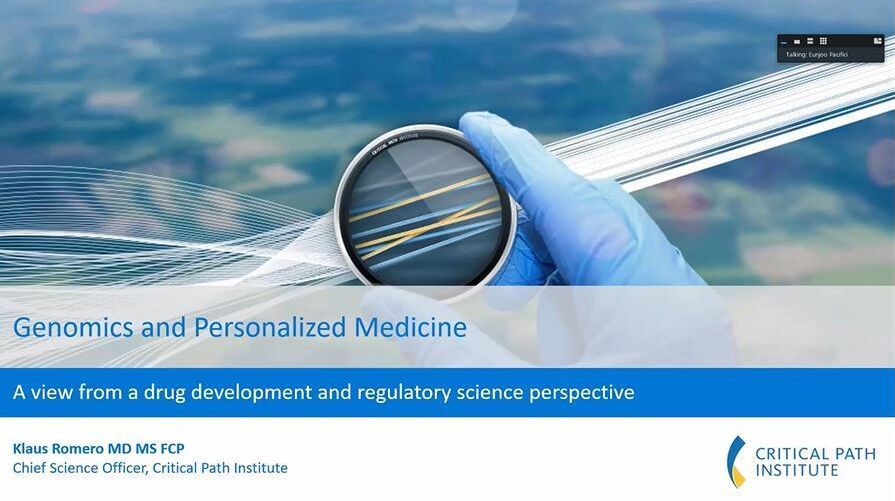- How C-Path came about
- Represents a critical pivot in FDA thinking
- In response to the Critical Path Initiative, the Critical Path Institute was formed as an independent 501(c)3 in 2005
- One of the most important documents in terms of the development of regulatory science
- How C-Path Works: Public-Private Partnerships
- One of the critical aspects of this was the notion of leveraging public-private partnerships
- At C-Path we generate legal, scientific, and legal infrastructure for multiple entities to come together and share solutions
- C-Path generates actionable solutions (in interesting packages)
- Process:
- Unmet medical need
- Companies come with trial specific problems
- For example struggling how to optimize the identification of the right dose in a clinical trial
- Companies come with trial specific problems
- Core Competencies
- Data and management and standards
- Biomarkers
- Modeling and Analytics
- Clinical outcomes assessments
- Regulatory / Development Science
- Concentration Area
- Neuroscience
- Immunology and inflammation
- Infectious disease
- Safety Science
- Rare/Orphan Diseases
- Pediatrics
- DDTs and Other Solutions
- Unmet medical need
- Process:
- Active C-Path Consort & Programs
- Critical Path for Alzheimer’s (CPAD)
- Data Collaboration Center (DCC)
- Polycystic Kidney Disease Outcomes Consortium (PKDOC)
- QuantMed (Quantitative Medicine)
- Type 1 Diabetes Consortium (T1D)
- Critical questions for trial design
- Typical questions to move the trial forward:
- How many patients should be recruited to properly power the trial?
- What should be the inclusion criteria?
- Can the control arm be optimized?
- What types of progression rates are expected for different subpopulations?
- What measures of progression are most adequate, at which stages of the disease continuum?
- How long should the trial duration be?
- How often should I assess?
- What is the time-varying probability of dropouts, and what are their predictors?
- These questions are the bread and butter of drug development in the trial space
- There is heterogeneity in patient groups that appear similar
- How do we answer these questions due to this?
- Typical questions to move the trial forward:
- Answer 1: Quantifying variability
- Quantifying multiple sources of variability simultaneously within the patient population reduces overall unexplained variability
- Shrinking the remaining residual variability
- Critical in rare diseases, especially those that have a genetic component
- Result: The ability to predict more accurate progression rates for heterogeneous subpopulations of patients in clinical trials
- Allows companies to see the remaining unpredictability and how much you know
- Important in practical terms (i.e. competing for funding)
- Answer 2: Multiple data sources
- Understanding the “universe” of a given diseases’ heterogeneity
- Trying to understand the full breadth of the variability
- Having the underlying data to it
- Result: The ability to more accurately account for the heterogeneity in rare diseases and avoid biased conclusions on few data sources
- Answer 3: Drug-disease-trial modeling
- Collection of models that help you understand the variability in a context that makes sense
- Disease progression and characterization model
- Three main components
- Set of quantitative description of the disease and how it moves dynamically
- Handle on drug effects and how it with affect the disease progression
- Drug effects model/disease modifying effect
- Trial Component
- Additional set of models that capture what happens in a clinical trial quantitatively
- Placebo effects model, dropout model
- Collection of models that help you understand the variability in a context that makes sense
- Clinical Data Contributed to C-Path
- Integrating patient data from the industry trials to build out these models
- Currently have 175,401 subject’s data
- Started in Alzheimer’s diseases
- Used for harmonization and standardization of certain aspects of the trials
- Data Science and Quantitative Medicine
- Data Collection
- Clinical trial, registry, natural history, RMT/3DT biomarker, translational, genetic, other novel data
- C-Path Data Collaboration Center
- Data Vault à Curation à Metadata Annotation & Standardization à Data Analysis (Data Lake and Data Warehouse) à C-Path QuantMed Program and working with other researchers à Actionable Drug Development Solutions
- Data Lake: notion is creating user friendly, secure cloud interface
- Density of each “layer” of data model
- Then can pull out subset from each layer and organize and analyze the data more effectively
- Density of each “layer” of data model
- Data Collection
- Building Quantitative Drug Development Tools Based on Standardized Integrated Data: PKA
- Model-Informed Drug Development (MIDD) serves as the approach to generate drug development tools
- Data collaboration that was launched last week: Rare Diseases Cures Accelerator Data and Analytics Platform
- Quantitative Medicine then transforms this data
- Multivariate TKV/eGFR Model
- Harmonization of images
- Depiction of the disease
- Image biomarker that captures the changes of the kidney over time
- Joint survival model for ESRD
- Allows for the time vary probability of patients developing end stage renal disease
- Underlying model developed on the data
- Problem in the data for the contribution of the genetic variants got swallowed up
- The concept of parsimonious models
- Covariant did not make it into the model
- This means that we can circle back to experimentalists and say they need to collect more data on these patients to fill in these gaps to fully understand the disease progression
- The Joint Model allows for this
- Provided the confidence for total kidney volume as a patient selection tools for patient trials
- Allowed for total kidney volume to be used as a surrogate marker
- So…?
- Allowed for the first drug approved by the FDA to modify the disease and progression of PKA
- Collaborative science transformed the landscape of drug development for PKD:
- First-ever drug approval to slow/halt disease progression
- Pipeline of over 14 drugs in development
- Expanded the PKD-OC database, leveraging the functionality of RDCA-DAP
- Leverage C-Path’s QuantMed Program, in collaboration with PKD-OC members, to expand the development of the CTS platform with additional mutation-specific data
- Leverage the collaborative framework and regulatory connectivity of the PKD-OC do drive the regulatory strategy for the clinical trial simulation platform
- Building Quantitative Drug Development Tools Based on Standardized Integrated Data: Alzheimer’s Disease
- Same Model-Informed Drug Development Model
- Hippocampal Neuroimaging-Informed Amnestic MCI Clinical Trial Simulator
- Women are underrepresented in Alzheimer’s trials
- Model provides different enrichment strategies or the trial
- Using an imaging biomarker to measure the level of atrophy in the hippocampus
- COVID Affected this model, and model was altered to adapt to missing components of the traditional trial
- So?
- News headlines aside, the first new drug approval represents a milestone
- Pipeline of over 21 drugs in development now
- News headlines aside, the first new drug approval represents a milestone
- TTE Disease Progression Model for T1D Prevention Trial
- Risk of T1D diagnosis stratified by the number of islet AAs present at the first patient record (including zero)
- Testing immune modulators to see if individuals who are having an immune response can be prevented
- Very hard patient population to build
- Need individual that have the autoantibodies
- Driven by genetic predisposition
- HLA subtypes and the AAs are both being considered
- So…
- Challenges, the first new drug review represents a milestone
- Pipeline getting interesting, with over 9 drugs in development
- Builds out the T1d-C data base
- Personalized medicine
- Challenges, the first new drug review represents a milestone
- Questions?
- Does C-Path provide guidance to your partners on plans for reducing unexplained variability within see paths focus areas, for example, is there guidance on how to recruit and stratify patients with dementia symptoms into those with and without Alzheimer’s?
- Yes, but in the context of recommendations for everyone. We do not consult individual companies but we look at a certain stage of the process.
- How do you collaborate with other agencies and what does that look like? How is the quality of the data?
- Yes, we collaborate with other agencies, EMA frequently. But we have to keep the two avenues separate as there are different guidance standards.
- Data cloud allows for easy data transactions
- The quality of the data is always an issue, especially when you move down the hierarchy of clinical trials to registries. Sometimes we have to tell the companies the data is not good.
- How is the access to the data?
- The data type and source can be different
- Need to do lots of security provisions
- For drugs that get approved based off data from tailored person’s participant populations is the approved treatment, and then only recommended to those particular populations, instead of the global population.
- It depends. If you have a qualified biomarker, it should usually not affect the labeling of the drug to the rest of the population. There are instances when you go too overboard.
- With C-Path’s large rich and sanitized data sets is anyone considering using the data directly, i.e. approval with real world evidence?
- Not yet. There is movement around this.
- Does C-Path provide guidance to your partners on plans for reducing unexplained variability within see paths focus areas, for example, is there guidance on how to recruit and stratify patients with dementia symptoms into those with and without Alzheimer’s?
- How has the recent approval of the new drug of Alzheimer’s effected the trial recruitment and efficacy modeling?
- The data from that program is being prepared as part of the data base. IT will inform some hefty improvement of the drug effect model component
- What goes into the selection of markers that you choose for the clinical trial biomarkers?
- It’s a combination of what makes sense for a potential biomarkers candidate to be included and access to data.
Regulatory Science Virtual Symposium: “Innovation to Translation: Role of Genomics in Medical Product Development:” Session 3: Genomics and Personalized Medicine – A View from a Drug Development and Regulatory Science Perspective (2021)
Topics
Acknowledgement
Accompanying text created by Annie Ly | Graduate Student, Regulatory Science, USC School of Pharmacy lyannie@usc.edu and Emily Donahue | Undergraduate Student, Pharmacology and Drug Development, USC School of Pharmacy emilydon@usc.edu

